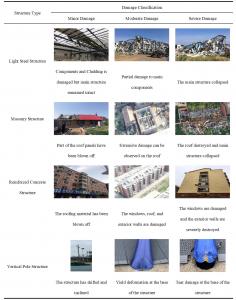Post-disaster investigation of building damage from local strong winds in China: 2021-2024
GA, UNITED STATES, December 18, 2024 /EINPresswire.com/ -- This paper presents the post-disaster investigations, highlighting wind-induced damage to various structures. Tornadoes caused EF 1–3 level damage, downbursts caused EF 1–2 damage. Damage levels for various structures were established based on observed characteristics. CFD simulations show that opening indoor doors increases wind speed from 27 to 45 m/s ( Venturi effect), closing them reduces it to 8 m/s. During strong winds, doors and windows should be closed, and balconies should have railings to prevent accidents.
Local strong winds, such as tornadoes and downbursts, are rarely captured in measured wind speed data due to their rapid formation and immense destructive power. As a result, post-disaster investigations have become essential for assessing the strength of these wind phenomena and analyzing structural failure mechanisms.
From 2021 to 2024, several tornados and downbursts occurred in China. A study published in Advances in Wind Engineering examined changes in wind disasters intensity along their paths using on-site disaster investigations and established structural damage rating standards.
“These standards assessed damage levels based on the extent of functional loss and repair required,” explains Qingshan Yang, lead author of the study. “We focused on the damage characteristics of light steel structures, masonry structures, steel-concrete structures and pole structures, analyzing the underlying causes of damage through construction methods and force transmission mechanisms.”
Additionally, the researchers estimated equivalent wind speeds based on damage to pole structures and metal roof claddings. Computational fluid dynamics (CFD) technology was used to simulate airflow distribution inside high-rise buildings under two conditions: with interior doors open and closed. The findings revealed that closing interior doors during strong winds significantly reduces indoor wind speeds, thereby enhancing safety.
“Our study detailed insights into several tornadoes and downbursts in China from 2021 to 2024 through on-site investigations. Key information such as their paths, durations and intensity variations is documented,” adds Yang. “The findings offer a critical scientific basis for understanding structural failure mechanisms during tornadoes and downbursts and optimizing structural designs in wind-prone regions.”
DOI
10.1016/j.awe.2024.100011
Original Source URL
https://doi.org/10.1016/j.awe.2024.100011
Funding information
The authors would like to acknowledge the financial support from National Natural Science Foundation of China (52221002, 52178457), Chongqing Science and Technology Talent Training Project (CSTB2023YSZX-JCX0007), National Key Research and Development Program of China (2023YFC3008503).
Lucy Wang
BioDesign Research
email us here
Legal Disclaimer:
EIN Presswire provides this news content "as is" without warranty of any kind. We do not accept any responsibility or liability for the accuracy, content, images, videos, licenses, completeness, legality, or reliability of the information contained in this article. If you have any complaints or copyright issues related to this article, kindly contact the author above.

